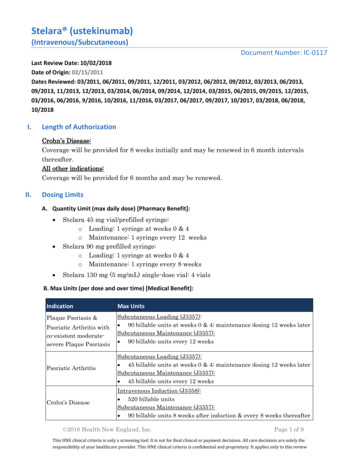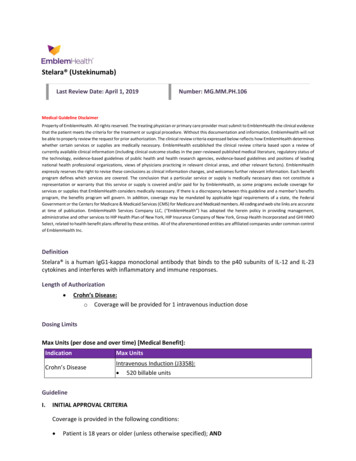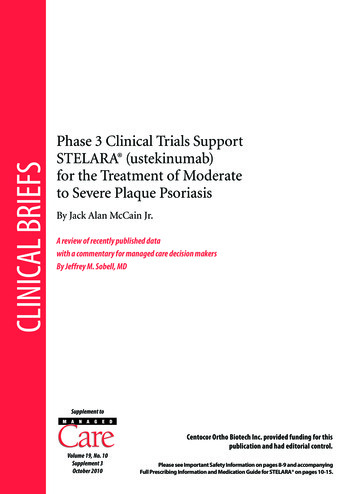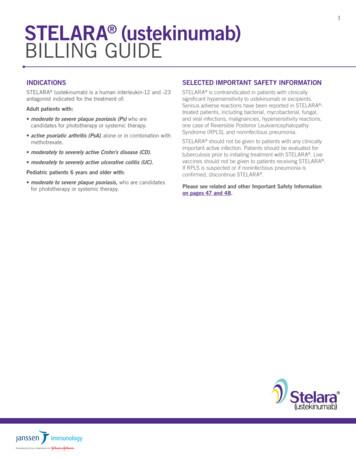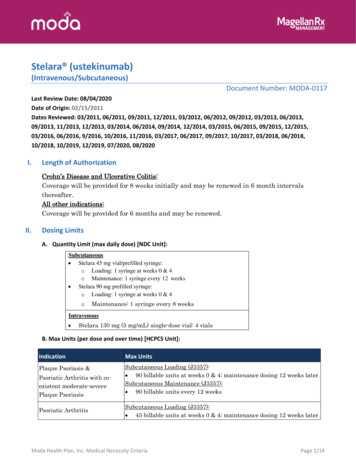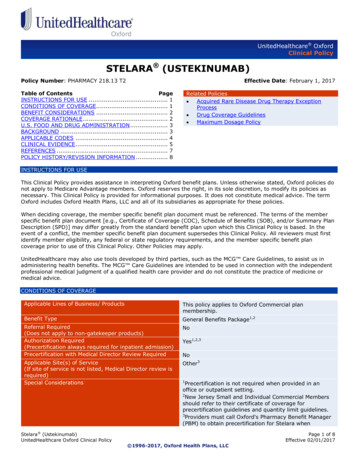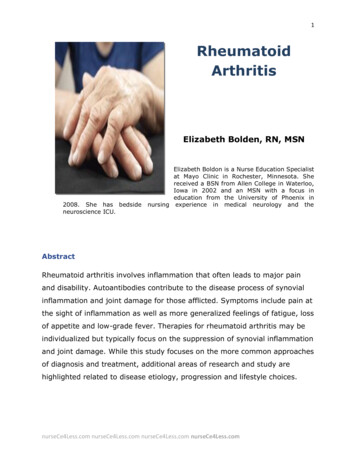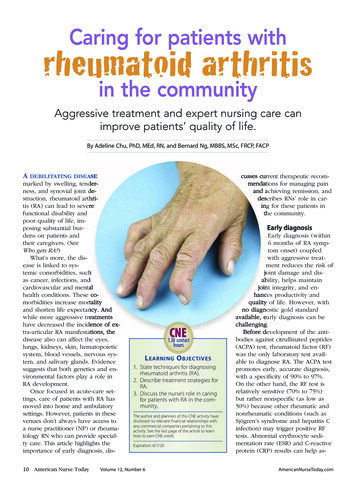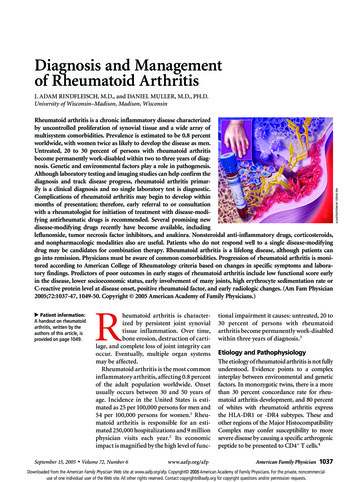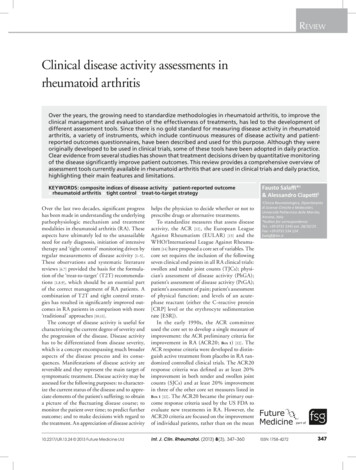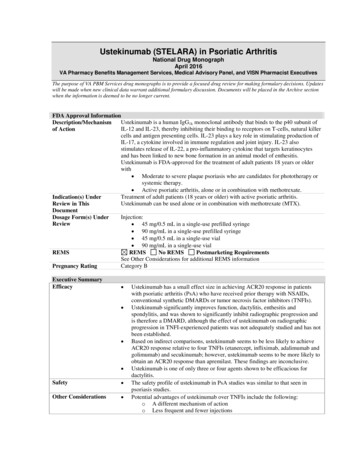
Transcription
Ustekinumab (STELARA) in Psoriatic ArthritisNational Drug MonographApril 2016VA Pharmacy Benefits Management Services, Medical Advisory Panel, and VISN Pharmacist ExecutivesThe purpose of VA PBM Services drug monographs is to provide a focused drug review for making formulary decisions. Updateswill be made when new clinical data warrant additional formulary discussion. Documents will be placed in the Archive sectionwhen the information is deemed to be no longer current.FDA Approval InformationUstekinumab is a human IgG1k monoclonal antibody that binds to the p40 subunit ofDescription/MechanismIL-12 and IL-23, thereby inhibiting their binding to receptors on T-cells, natural killerof Actioncells and antigen presenting cells. IL-23 plays a key role in stimulating production ofIL-17, a cytokine involved in immune regulation and joint injury. IL-23 alsostimulates release of IL-22, a pro-inflammatory cytokine that targets keratinocytesand has been linked to new bone formation in an animal model of enthesitis.Ustekinumab is FDA-approved for the treatment of adult patients 18 years or olderwith Moderate to severe plaque psoriasis who are candidates for phototherapy orsystemic therapy. Active psoriatic arthritis, alone or in combination with methotrexate.Treatment of adult patients (18 years or older) with active psoriatic arthritis.Indication(s) UnderUstekinumab can be used alone or in combination with methotrexate (MTX).Review in ThisDocumentInjection:Dosage Form(s) UnderReview 45 mg/0.5 mL in a single-use prefilled syringe 90 mg/mL in a single-use prefilled syringe 45 mg/0.5 mL in a single-use vial 90 mg/mL in a single-use vialREMSREMSNo REMSPostmarketing RequirementsSee Other Considerations for additional REMS informationCategory BPregnancy RatingExecutive SummaryEfficacy Safety Other Considerations Ustekinumab has a small effect size in achieving ACR20 response in patientswith psoriatic arthritis (PsA) who have received prior therapy with NSAIDs,conventional synthetic DMARDs or tumor necrosis factor inhibitors (TNFIs).Ustekinumab significantly improves function, dactylitis, enthesitis andspondylitis, and was shown to significantly inhibit radiographic progression andis therefore a DMARD, although the effect of ustekinumab on radiographicprogression in TNFI-experienced patients was not adequately studied and has notbeen established.Based on indirect comparisons, ustekinumab seems to be less likely to achieveACR20 response relative to four TNFIs (etanercept, infliximab, adalimumab andgolimumab) and secukinumab; however, ustekinumab seems to be more likely toobtain an ACR20 response than apremilast. These findings are inconclusive.Ustekinumab is one of only three or four agents shown to be efficacious fordactylitis.The safety profile of ustekinumab in PsA studies was similar to that seen inpsoriasis studies.Potential advantages of ustekinumab over TNFIs include the following:o A different mechanism of actiono Less frequent and fewer injections
Ustekinumab in Psoriatic Arthritis, MonographoooProjected Place inTherapy BackgroundPurpose for ReviewOther TherapeuticOptionsLower incidence of injection site reactions (versus etanercept)Lack of cytopeniasLack of TNFI complications or contraindications such as heart failure,demyelinating disease and lupus-like syndromeBased on the evidence from clinical trials and current practice guidelines,ustekinumab would be useful as an alternative to TNFIs when TNFIs areinappropriate in patients with active psoriatic arthritis despite treatment with atleast one csDMARD OR for switching biologic mechanism in patients withactive disease despite induction treatment with one or more TNFIs.Studies directly comparing ustekinumab with other agents are lacking.The presence of dactylitis might be a reason to use infliximab, certolizumab,ustekinumab or perhaps golimumab.High risks for infection and tuberculosis are patient factors that may influence adecision to use ustekinumab, apremilast (if there is no joint erosion) or perhapsetanercept over other biologic agents as first-line therapy in PsA.To review the comparative safety and efficacy of ustekinumab in psoriatic arthritis(PsA) to inform an update to the VA PBM-MAP-VPE criteria for use of biologicsin psoriasis and PsA. Ustekinumab currently remains nonformulary.Issues to be determined: Does ustekinumab offer efficacy or safety advantages over other drug options? Are there subgroup response predictors for efficacy or safety?Conventional synthetic disease-modifying antirheumatic drugs (csDMARDs) suchas methotrexate and leflunomide are generally considered for moderate to severePsA or as second-line therapies after nonsteroidal antiinflammatory drugs(NSAIDs) for mild PsA. Other therapeutic options at approximately the same lineof therapy as ustekinumab are shown in the tables below.Formulary AlternativesNoneOther ConsiderationsClinical GuidanceNonformulary AlternativesTumor Necrosis limumabInfliximabOther ConsiderationsEffectiveness is establishedin PsA.Administeredsubcutaneously exceptinfliximab is emilastOrally administered.Disease-modifyingcapability is uncertain.Anti-IL-17A MonoclonalAntibodySecukinumabApproved for PsA in1/2016. Administeredsubcutaneously.Inhibits radiographicprogression.1Clinical GuidanceGenerally used forinadequate responders tocsDMARDs for moderateto severe PsA or may beused first-line in severePsA; generally givenconcomitantly with acsDMARD.1PBM Criteria for Use inPsA are available.Place in therapy isunclear.PBM Criteria for Use inPsA are available.European League AgainstRheumatism (EULAR)guideline for PsA statesthat secukinumab may beconsidered in patients withperipheral arthritis and aninadequate response to atleast one csDMARD andfor whom TNFIs are2inappropriate.Updated version may be found at www.pbm.va.gov or PBM INTRAnet2
Ustekinumab in Psoriatic Arthritis, MonographEfficacy (FDA Approved Indications)Literature Search SummaryA literature search was performed on PubMed/Medline (1966 to January 2016) using the search terms ustekinumaband psoriatic arthritis. The search was limited to studies performed in humans and published in the Englishlanguage. Reference lists of review articles and the manufacturer’s AMCP dossier were searched for relevantclinical trials. All randomized controlled trials and long-term studies ( 1 year) published in peer-reviewed journalswere included. An FDA Medical Review on psoriatic arthritis trials was not available.Review of EfficacyMajor Efficacy-Safety Trials In two multicenter, double-blind, placebo-controlled Phase 3 RCTs (PSUMMIT 1 and PSUMMIT 2),ustekinumab 90 mg and 45 mg were significantly better than placebo in achieving at least 20% improvement inAmerican College of Rheumatology scores (ACR20). Results were consistent across the trials.o In PSUMMIT 1 (N 615, mean age 48 years, 53.6% men, 4 years with PsA, 13 years withpsoriasis), patients had active PsA despite 4 weeks of NSAID therapy or 3 months of csDMARDtherapy (without TNFI). About half (48.1%) of the patients were taking methotrexate (mean, 16mg/week). ACR20 responder rates at Week 24 were 50%, 42% and 23% for ustekinumab 90 mg, 45mg and placebo, respectively.3 NNTs were 4 and 6 for the 90-mg and 45-mg dose, reflecting small tonear-moderate effect sizes.4 Response rates showed significant treatment differences versus placebostarting at Week 8, peaked at Week 28 and were maintained at Week 52. ACR20 response was similarbetween subgroups who did and did not receive concomitant methotrexate therapy (44.5% and 47.4%,respectively, for ustekinumab (pooled 90 mg and 45 mg) versus 26.0% and 20.0%, respectively, forplacebo.6o In PSUMMIT 2 (N 312, mean age 48 years, 52.6% men, 5 years with PsA, 12 years withpsoriasis), patients had active PsA despite use of either csDMARDs or 8 weeks of TNFI therapy(except 14 weeks for infliximab) or shorter periods in case of intolerance. About half (49.7%) of thepatients were taking methotrexate (mean, 17 mg/week). Of the planned 300 randomized patients, 150to 180 (50% to 60%) were required to have prior TNFI treatment regardless of the reason therapy wasdiscontinued. ACR20 responder rates at Week 24 were 44%, 44% and 20% for ustekinumab 90 mg, 45mg and placebo, respectively.5 NNT was 5 (small effect size) for both the 90-mg and 45-mg doses.4ACR20 responder rates in the subgroup of patients who previously used TNFIs were 36% forustekinumab (pooled 90 mg and 45 mg) and 15% for placebo (p 0011).6o Statistically significant and clinically relevant improvement in function (Health AssessmentQuestionnaire-Disability Index [HAQ-DI] increase of at least 0.3) occurred in 48%, 48% and 28% ofthe 90-mg, 45-mg and placebo groups at Week 24 of PSUMMIT 1. HAQ-DI change was –0.25, –0.25and 0.00 in the 90-mg, 45-mg and placebo groups, respectively, in PSUMMIT 1, and thecorresponding values were –0.25, –0.13 and 0.00 in PSUMMIT 2.o Ustekinumab significantly improved psoriasis in both PSUMMIT trials, showing a large effect size.NNTs for 75% improvement in Psoriasis Area and Severity Index (PASI75) relative to placebo were1.9–2.0 and 2.0–2.2 for 90 mg and 45 mg, respectively, in PSUMMIT 1 and PSUMMIT 2.4o In PSUMMIT 1, ustekinumab (pooled 90 mg and 45 mg), as compared with placebo, resulted in asignificantly lower percentage of patients with residual dactylitis (56.2% and 76.1%; p 0.0013) andenthesitis (64.6% and 81.0%; p 0.0006) at Week 24. Dactylitis and enthesitis scores also showedsignificantly greater improvements from baseline with ustekinumab than placebo. In the 2-year studydata, the median percent improvement in dactylitis and enthesitis was 100% at Week 100. 7o Ustekinumab therapy also showed significant benefit in terms of exploratory axial disease /“spondylitis” outcome measures at Week 24. In PSUMMIT 1, a significantly greater percentage ofpatients with axial and peripheral PsA on ustekinumab (pooled 45 and 90 mg) than patients on placebo(27.9% vs. 13.1%; p 0.0232) achieved at least 50 percent reduction on the Bath ankylosingspondylitis disease activity index (BASDAI50). Significant differences were also found for BASDAI20 and 70. Improvement was maintained at Week 100.8 In PSUMMIT 2, BASDAI50 responder rateswere also significantly greater with ustekinumab (pooled 45 mg and 90 mg) than placebo (32.6% vs.Updated version may be found at www.pbm.va.gov or PBM INTRAnet3
Ustekinumab in Psoriatic Arthritis, Monograph 5.6%, respectively) at week 24.5 BASDAI20 showed no significant differences and BASDAI70 wasnot evaluated. BASDAI score 3 was numerically greater on ustekinumab than placebo (30.4% vs.5.6%; NSD). A decrease in BASDAI by 50% or 2 points is considered clinically meaningful inankylosing spondylitis, a condition that differs from axial PsA in demographic, clinical and geneticcharacteristics.9 The use of BASDAI in PsA studies is novel and the index has not been validated forPsA.3,5,9o In pooled integrated data from PSUMMIT 1 and PSUMMIT 2, ustekinumab therapy led tosignificantly less radiographic progression of joint damage from baseline to Week 24 relative toplacebo (mean change from baseline in van der Heijde-Sharp (vdH-S) scores: 0.4 for combined andfor individual ustekinumab dose groups versus 1.0 for placebo (all p 0.02).10 Changes in vdH-Sscores of 0.0 occurred in 69.0% of the ustekinumab 90-mg group (p 0.026), 64.0% of the 45-mggroup (NSD), and 66.5% of pooled ustekinumab groups (p 0.061) versus 59.8% of placebo patients.Inhibition of joint damage was maintained at Week 52. In the 2-year study data for PSUMMIT 1,inhibition of radiographic progression was maintained through Week 100.7 The effect of ustekinumabon radiographic progression in TNFI-experienced patients was not adequately studied and has not beenestablished.A third, earlier multicenter, double-blind, placebo-controlled, crossover RCT showed that ustekinumab (90 or63 mg) achieved ACR20 at 12 weeks in 42% of 76 patients as compared with 14% of 70 placebo patients (NNT 4).11 Response was maintained through 36 weeks in the majority of patients. Ustekinumab therapy also led tosignificantly greater improvements in physical functioning and health-related quality of life relative toplacebo.12Ustekinumab Versus Other Agents in PsA A National Institute of Health and Care Excellence (NICE) technology report of ustekinumab in PsAsummarized information from a confidential mixed treatment comparison performed by the drug manufacturer. 6Ustekinumab was indirectly compared with TNFIs in people who were TNFI-naïve in terms of PsoriaticArthritis Response Criteria (PsARC), PASI75 and PASI90 responses at weeks 12–16 and 24. The evaluationdid not consider patients who were TNFI-experienced. Ustekinumab seemed to be less effective than TNFIs forpsoriatic arthritis, particularly in terms of PsARC responder rates but also for PASI75 and PASI90.o For joint symptoms (PsARC), the probabilities of response were lower for ustekinumab; however, the95% credible intervals for ustekinumab 45 mg overlapped with those of adalimumab, golimumab 50mg and infliximab.o For skin symptoms, the probabilities of response were lower for ustekinumab and other biologicsrelative to infliximab (PASI75 and PASI90), golimumab 100 mg (PASI75) and adalimumab (PASI90);however, the 95% credible intervals overlapped. Based on indirect comparisons of an e-published systematic review / meta-analysis of 12 RCTs of 12 or moreweeks in duration (N 1989 for the active arms and N 1175 for the placebo arms), ustekinumab wassignificantly less likely to achieve ACR20 response at weeks 12–24 relative to four TNFIs (etanercept,infliximab, adalimumab and golimumab) and secukinumab in patients with active PsA despite csDMARD orNSAID therapy.13 Apremilast and certolizumab also seemed to be less likely to achieve ACR20 response thaneach of the four TNFIs and secukinumab, and there was no significant difference between ustekinumab andcertolizumab. The ACR20 response risk ratio relative to placebo was 4.42 (95% CI 3.54–5.51) for the fourTNFIs (pooled), 1.86 (1.43–2.42) for ustekinumab 45 mg and 2.12 (1.64–2.73) for ustekinumab 90 mg. Thesefindings are inconclusive. Limitations of the meta-analysis included the potential for faulty assumptions of thestatistical method used for indirect comparisons, potential bias associated with manufacturer sponsorship of thetrials, and lack of assessment of axial disease activity or radiographic progression. Head-to-head RCTs areneeded to verify the results.Updated version may be found at www.pbm.va.gov or PBM INTRAnet4
Ustekinumab in Psoriatic Arthritis, MonographTable 1 Indirect Comparisons of Four TNFIs Versus Other PsATherapies: ACR20 Responder RateIndirect ComparatorRR (95% CI)Certolizumab2.20 (1.48–3.26)*Apremilast 20 mg3.36 (2.10–5.38)*Apremilast 30 mg2.42 (1.55–3.77)*Ustekinumab 45 mg2.38 (1.68–3.35)*Ustekinumab 90 mg2.08 (1.48–2.93)*Secukinumab 75 mg1.90 (0.95–3.78)Secukinumab 150 mg1.10 (0.58–2.09)Secukinumab 300 mg1.21 (0.63–2.29) The four TNFIs wereadalimumab, etanercept,golimumab and infliximab.Relative risk (RR) refers to thefour TNFIs as a group relative tothe other agents.*P 0.001Based on NNT point estimates reported in a EULAR systematic literature review, responses were numericallyhigher with ustekinumab and secukinumab as compared with apremilast for joint (ACR20) outcomes andparticularly for skin (PASI75) outcomes (Table 2).4 Indirect treatment comparisons showed similar trends fordactylitis. Comparisons between agents are greatly limited by differences between trials in population mix,observation time points and other methodologic aspects.Table 2Number Needed to Treat for ACR and PASI OutcomesIntervention,TrialTime PointmgACR20 NNT ACR50 NNTPALACE 116 wkAPR 305.2—APR 208.8—PALACE 216 wkAPR306.7—APR 205.3—PALACE 316 wkAPR 304.2—APR 209.5—PALACE 416 wkAPR 306.5—APR 208.1—PSUMMIT 124 wkUST 903.75.2UST 455.16.2PSUMMIT 224 wkUST 904.26.2UST 454.39.3FUTURE 124 wkSEC 1503.13.7SEC 753.04.3FUTURE 224 wkSEC 3002.63.6SEC 1502.83.6SEC 757.19.0PASI75 17.9Source: Ref 4ACR20, AmericanCollege ofRheumatology 20%improvement;APR, Apremilast;PASI75, Psoriasisarea and severityindex 75%improvement;SEC, Secukinumab,UST, UstekinumabComparative Summary of Pharmacologic Treatments for Specific Conditions in PsAWork groups of the Group for Research and Assessment of Psoriasis and Psoriatic Arthritis (GRAPPA) haveperformed a series of systematic reviews of the literature to update treatment guidelines for PsA. For each of thespecific conditions, two or more TNFIs showed efficacy and may be used as alternative therapies. The systematicreview of treatments for psoriasis in PsA14 was largely based on the approved indications for agents and is notsummarized here.Peripheral Arthritis15 In a systematic review of RCTs and observational studies, indirect comparisons of treatments relative to placebosuggested that ustekinumab and adalimumab had moderate effect sizes for health assessment questionnaire(HAQ) outcomes (0.65 and 0.49, respectively) at 12 weeks. HAQ effect sizes at later time points were notavailable for ustekinumab but could be calculated for infliximab (0.87, large) at 16 weeks; leflunomide (0.29,small), adalimumab (0.67, moderate), infliximab (1.17, very large), and golimumab (0.65, moderate) at 24weeks; and cyclosporine (–0.18, NSD) at 48 weeks. Ustekinumab, adalimumab and apremilast had comparableNNTs for ACR20 at 12 weeks (Table 3).Updated version may be found at www.pbm.va.gov or PBM INTRAnet5
Ustekinumab in Psoriatic Arthritis, MonographTable 3Number Needed to Treat for ACR20Intervention,Time Point, wk mean dose, mgACR20 NNT12ADA 40 qowk512APR 20 bid412APR 40 qd512UST 90 qwk416INF 5 / kg224ABT 10 mg/kg424ADA 40 qowk324CER 200 q2wk324ETA 25 biwk324GOL 50 qmo324INF 5 / kg3Source: Ref 15ABT, Abatacept;ADA, Adalimumab;APR, Apremilast;CER, Certolizumab;ETA, Etanercept;GOL, Golimumab;INF, Infliximab;UST, UstekinumabDactylitis16 According to a systematic review of 29 open-label observational studies or RCTs that evaluated treatments forPsA and reported dactylitis as an outcome measure (N 6589), ustekinumab is one of only three or four agentsshown to be efficacious for dactylitis. When calculable, the effect size relative to placebo for mean change in dactylitis score from baseline was 0.29(small) at 24 weeks with ustekinumab (2 RCTs), 0.41 (moderate) at 16 weeks with infliximab (1 RCT) and0.50 (moderate) at 24 weeks with certolizumab (1 RCT). Golimumab also showed efficacy in two Phase II trials. Open-label observational studies have suggestedpotential benefit with adalimumab, but 3 RCTs failed to show efficacy with this agent. Etanercept improveddactylitis from baseline but needs to be evaluated in controlled trials. Apremilast produced no significant benefitin RCTs. (Apremilast was associated with 100% median reduction in dactylitis counts only after 52 weeks oftherapy in a study without a placebo control.17) The effects of anakinra on dactylitis remain unclear.Enthesitis18 High-quality data from RCTs showed that the TNFIs certolizumab, golimumab and infliximab and the nonTNFIs apremilast (30 mg twice daily) and ustekinumab significantly improve enthesitis. Adalimumab showedno significant differences from placebo in exploratory analyses (with inadequate sample size) of two RCTs andhas not been adequately studied. With etanercept, 70% and 80% of patients experienced improvements inenthesitis scores from baseline to 12 and 24 weeks, respectively; however, the study had no placebo control. Effect sizes, based on different enthesitis measures, were moderate for golimumab at 14–24 weeks andcertolizumab at 24 weeks, and small for ustekinumab and apremilast at 24 weeks. NNTs for infliximab were 5.9to 8.3 over 14 to 24 weeks, reflecting small effect sizes. Only the
Ustekinumab (STELARA) in Psoriatic Arthritis National Drug Monograph April 2016 VA Pharmacy Benefits Management Services, Medical Advisory Panel, and VISN Pharmacist Executives The purpose of VA PBM Services drug monographs is to provide a fo
